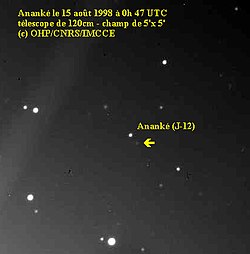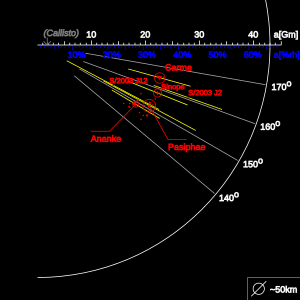아난케 (위성)
| 아난케 Ananke | ||

| ||
| 발견 | ||
|---|---|---|
| 발견자 | 세스 반스 니컬슨 | |
| 발견일 | 1951년 9월 28일 | |
| 궤도 성질 | ||
| 모행성 | 목성 | |
| 궤도 긴반지름(a) | 21,280,000 km[1] | |
| 근점(q) | 12,567,000 | |
| 원점(Q) | 29,063,500 | |
| 공전 주기(P) | 610.45 일 (1.680 년)[1] | |
| 평균 공전 속도 | 2.367 | |
| 궤도 경사(i) | 148.89°(황도 기준) 149.9°(목성의 적도 기준)[1] | |
| 궤도 이심률(e) | 0.24[1] | |
| 물리적 성질 | ||
| 반지름 | 14 km[2] | |
| 평균 밀도 | 2.6 g/cm3 | |
| 질량 | 3.0×1016 | |
| 표면 중력 | 0.010 m/s2 | |
| 탈출 속도 | 0.017 km/s | |
| 반사율 | 0.04[3] | |
| 겉보기등급 | 18.9[4] | |
| 절대등급(H) | 11.84 ± 0.03[5] | |
| 평균 온도 | ~124 K | |
아난케(영어: Ananke[참조 1], 그리스어: Ανάγκη)는 목성의 역행 불규칙 위성이다. 아난케는 세스 반스 니컬슨이 1951년에 윌슨 산 천문대에서 발견하였고,[6] 아난케라는 이름은 그리스 신화의 아난케에서 유래했다. 현재까지 아난케에 대해 알려진 사항은 그리 많지 않다.[4]
명칭
[편집]아난케는 1975년까지 "아난케"라고 불리지 않았는데,[7][8] 그 전에는 단순히 "목성 XII"(Jupiter XII)로 불렸으며, 1955년부터 1975년까지는 "아드라스테아"라고도 불렸다(현재 아드라스테아는 목성의 다른 위성의 이름이다).[9]
아난케는 아난케 군의 이름의 유래가 되었는데, 아난케 군은 아난케와 비슷한 궤도를 도는 위성들(목성과의 궤도 경사가 150°이고 목성에서 19.3 ~ 22.7 기가미터[참조 2] 떨어져 목성을 공전하는 역행 위성들)의 모임이며,[3] 아난케 군이 아난케의 이름을 따 불리게 된 까닭은 단순히 아난케 군에서 아난케가 가장 크기 때문이다.[5]

궤도
[편집]
아난케는 매우 찌그러져 있고(이심률이 높고) 궤도 경사 또한 큰 역행 궤도를 돌고 있다.[3] 아난케의 궤도 정보는 2000년 1월의 정보이며,[1] 이는 목성이나 태양으로부터의 궤도 섭동 현상으로 인해 계속해서 변하고 있다.
지금까지 알려진 궤도 정보와 물리적 성질들을 통해, 아난케는 아난케 군을 형성했던 최초의 덩어리가 충돌로 인해 갈라져 생긴 조각 중 가장 큰 조각이라고 추측되고 있고,[10][11][12] 아난케 군을 형성했던 기존의 소행성체의 지름은 약 14 km로 추정되고 있다.[10]
물리적 성질
[편집]가시광선 대역의 스펙트럼 분석에서, 아난케는 밝은 적색으로 나타난다(색지수 B-V=0.90 V-R=0.38).[12]
적외선 스펙트럼에서는 아난케가 P형 소행성과 유사하게 나타났으며, 물이 존재할 가능성 또한 보여졌다.[13]
같이 보기
[편집]각주
[편집]- 내용주
- ↑ 발음 기호는 /əˈnæŋkiː/이다.
- ↑ 19 700 000 ~ 22 700 000 km
- 참조주
- ↑ 가 나 다 라 마 Jacobson, R. A. (2000). “The Orbits of Outer Jovian Satellites”. 《Astronomical Journal》 120 (5): 2679–2686. Bibcode:2000AJ....120.2679J. doi:10.1086/316817.
- ↑ “Jovian Satellite Fact Sheet”.
- ↑ 가 나 다 Scott S. Sheppard; David C. Jewitt; Carolyn Porco (2004). [ttp://www.ifa.hawaii.edu/~jewitt/papers/JUPITER/JSP.2003.pdf 《Jupiter: The Planet, Satellites and Magnetosphere (Cambridge Planetary Science)》] (PDF) 1. Cambridge University Press. 263-280쪽. ISBN 0-521-81808-7.
- ↑ 가 나 “Jupiter's moon Ananke”. 《Views of the Solar System》.
- ↑ 가 나 T. Grav; J. M. Bauer; A. K. Mainzer; J. R. Masiero; C. R. Nugent; R. M. Cutri; S. Sonnett; E. Kramer (2015년 8월 10일). “NEOWISE: OBSERVATIONS OF THE IRREGULAR SATELLITES OF JUPITER AND SATURN” (PDF). 《The Astrophysical Journal》 809 (3): 9-18. doi:10.1088/0004-637X/809/1/3.
- ↑ Nicholson, S. B. (1951). “An unidentified object near Jupiter, probably a new satellite”. 《Publications of the Astronomical Society of the Pacific》 63 (375): 297–299. Bibcode:1951PASP...63..297N. doi:10.1086/126402.
- ↑ Nicholson, S.B. (1939년 4월). “S. B. Nicholson declines to name the satellites of Jupiter he has discovered”. 《Publications of the Astronomical Society of the Pacific》 51 (300): 85–94. Bibcode:1939PASP...51...85N. doi:10.1086/125010.
- ↑ Marsden, B. G. (1974년 8월 7일). “Satellites of Jupiter”. 《IAUC Circular》 2846.
- ↑ Payne-Gaposchkin, Cecilia; Katherine Haramundanis (1970). 《Introduction to Astronomy》. Englewood Cliffs, N.J.: Prentice-Hall. ISBN 0-13-478107-4.
- ↑ 가 나 Sheppard, S.S.; Jewitt, D.C. (2003). “An abundant population of small irregular satellites around Jupiter” (PDF). 《Nature》 423 (6937): 261–263. Bibcode:2003Natur.423..261S. doi:10.1038/nature01584. PMID 12748634. 2006년 8월 13일에 원본 문서 (PDF)에서 보존된 문서.
- ↑ Nesvorný, D.; Beaugé, C.; Dones, L. (2004). “Collisional Origin of Families of Irregular Satellites”. 《The Astronomical Journal》 127 (3): 1768–1783. Bibcode:2004AJ....127.1768N. doi:10.1086/382099.
- ↑ 가 나 Grav, Tommy; Holman, M. J.; Gladman, B. J.; Aksnes, K. (2003). “Photometric survey of the irregular satellites”. 《Icarus》 166 (1): 33–45. arXiv:astro-ph/0301016. Bibcode:2003Icar..166...33G. doi:10.1016/j.icarus.2003.07.005.
- ↑ Grav, Tommy; Holman, Matthew J. (2004). “Near-Infrared Photometry of the Irregular Satellites of Jupiter and Saturn”. 《The Astrophysical Journal》 605 (2): L141–L144. arXiv:astro-ph/0312571. Bibcode:2004ApJ...605L.141G. doi:10.1086/420881.
외부 링크
[편집]- (영어) IAU-MPC NSES
- (영어) Ananke Profile by NASA's Solar System Exploration
- (영어) David Jewitt pages
- (영어) Scott Sheppard pages
거리 순으로 나열되어 있으며, 임시 명칭은 기울임꼴로 되어 있다. | |
안쪽 위성 (아말테아군) | |
| 갈릴레이 위성 | |
| 테미스토군 | |
| 히말리아군 | |
| 카르포군 | |
| 발레투도군 |
|
| 아난케군 |
|
| 카르메군 | |
| 파시파에군 |
|
| |
Text is available under the CC BY-SA 4.0 license; additional terms may apply.
Images, videos and audio are available under their respective licenses.
